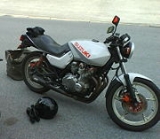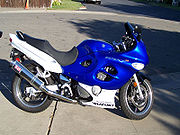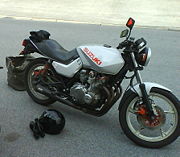
Suzuki Katana
Encyclopedia
- This article is about the 1980s motorcycle, for the scooter see Suzuki Katana AY50Suzuki Katana AY50The Suzuki Katana AY50 is a 50 cc scooter produced by Suzuki and sold primarily in Europe. starting in 1997. It is named for the katana samurai sword, as well as the early 1980s motorcycle of the same name...
The original Suzuki Katana was a then-novel sport
Sport bike
A sport bike, also written as sportbike, is a motorcycle optimized for speed, acceleration, braking, and cornering on paved roads, typically at the expense of comfort and fuel economy in comparison to less specialized motorcycles...
motorcycle
Motorcycle
A motorcycle is a single-track, two-wheeled motor vehicle. Motorcycles vary considerably depending on the task for which they are designed, such as long distance travel, navigating congested urban traffic, cruising, sport and racing, or off-road conditions.Motorcycles are one of the most...
designed in 1979–1980 by the southern Bavaria
Bavaria
Bavaria, formally the Free State of Bavaria is a state of Germany, located in the southeast of Germany. With an area of , it is the largest state by area, forming almost 20% of the total land area of Germany...
n firm of Target Design at the request of Suzuki
Suzuki
is a Japanese multinational corporation headquartered in Hamamatsu, Japan that specializes in manufacturing compact automobiles and 4x4 vehicles, a full range of motorcycles, all-terrain vehicles , outboard marine engines, wheelchairs and a variety of other small internal combustion engines...
of Germany specifically for their market.
The Katana
Katana
A Japanese sword, or , is one of the traditional bladed weapons of Japan. There are several types of Japanese swords, according to size, field of application and method of manufacture.-Description:...
name was later applied to a range of sport touring
Sport touring
A Sport touring motorcycle is a type of motorcycle that blends the performance of a sport bike with the long-distance capabilities of a touring motorcycle, while providing comfort and relative safety to the rider....
motorcycles in North America through the 2006 model year (also offered in Europe but without the Katana moniker), and starting at the change of the millennium to a line of 49 cc / 50 cc scooters in Europe.
Design history
The Katana's design started when Suzuki hired Hans Muth, ex-chief of styling for BMWBMW
Bayerische Motoren Werke AG is a German automobile, motorcycle and engine manufacturing company founded in 1916. It also owns and produces the Mini marque, and is the parent company of Rolls-Royce Motor Cars. BMW produces motorcycles under BMW Motorrad and Husqvarna brands...
, to update the company's image.

The design worked through several variations, with the public being allowed to see the ED1 and ED2 versions. This original design was a 650 cc model called the ED-1 (European Design 1).
The ED1 design featured a forward nose and a shaped, blended fuel tank with a merged fuel tank-to-seat arrangement at a time when squared off fuel tanks and flat-faced bolt-on accessory fairings were the norm. The design also incorporated favorable aerodynamics, with a special emphasis placed on high-speed stability, and was repeatedly wind-tunnel tested in Italy. The same generalized design forms had already been used early in 1979 for a one-off MV Agusta
MV Agusta
MV Agusta is a motorcycle manufacturer founded in 1945 near Milan in Cascina Costa, Italy. The company began as an offshoot of the Agusta aviation company formed by Count Giovanni Agusta in 1923. The Count died in 1927, leaving the company in the hands of his wife and sons, Domenico, Vincenzo,...
from the same design team, which never saw production.

In 1980 at Intermot
Intermot
INTERMOT Cologne is a biennial trade show for motorcycle manufacturers. The trade show began in Munich in 1998, though originally founded in Cologne. Since 2004 it has moved to koelnmesse in Cologne. The Intermot 2006 had over 1.000 exhibitors and some 187.000 visitors....
, the Cologne motor show, came the ED-2, an 1100 cc version based on the Suzuki GS 1100
Suzuki GS series
The Suzuki GS series is a line of motorcycles featuring air-cooled parallel-twin and Inline four engines with two or four valves per cylinder. The GS-range of models are considered to be examples of Universal Japanese motorcycles. The range of motorcycles in the series had engine displacements...
. Today, the only Katana-prototype outside Japan stands in Austria's Motorradmuseum Eggenburg 100 km (62.1 mi) northwest of Vienna. This was followed in 1981 with almost no changes to the production version, which is often seen as the Katana, as the design was so distinctive. The design was so successful in its basic form that these additional components were never made, apart from a small wind deflector screen. The unusual overlapping dials on the instrumentation were the result of arranging the mechanical components to fit as closely together as possible to reduce weight and costs.
The petrol filler was offset from the centerline of the tank to allow for a clean continuous seam weld. This design philosophy was applied to all areas of the bike's design, thus reducing the costs, weight, and number of components required.
There were two racing models worthy of note. The GSX1000 (circa 1981) is a now very rare model with more aggressive camshafts, flat-slide carburettors and wire wheels homologated
Homologation (motorsport)
In motorsports, homologation is the approval process a vehicle, race track or standardised part must go through to race in a given league or series. The regulations and rules that must be met are generally set by the series' sanctioning body...
for then international superbike racing rules. The GSX1100SXZ, also from 1981 and with wire wheels, more aggressive camshafts but with CV carburettors in Australia. New Zealand models were fitted with oval bore slide carbs. An extra air inlet hole adjacent to the standard one in the air box and large bore mufflers (same as fitted to the previous Castrol 6 Hour
Castrol 6 Hour
The Castrol Six Hour was a motorcycle race for production motorcycles, held in Australia from 1970 through to 1987.-History:The race was run by the Willoughby District Motorcycle Club and held at Amaroo Park until 1983, when it was moved to Oran Park for 1984 until the final race in 1987...
special the GSX100ET). This model was designed for production racing in a number of countries, including Australia and South Africa. Legend says there were 500 made, though it may be up to 800. Chassis numbers began with GS110X-100388. The 1100s were raced with mixed success in Australia in 1981, but rule changes for the 1982 Castrol 6-Hour production race saw teams scrambling to find 1000cc versions. In New Zealand the wire wheeled bike was fielded to meet the then new Honda CB1100R
Honda CB1100R
The CB1100R was an exotic Honda model that was produced in limited numbers from 1981–1983. It was a full fairing sport bike based on the Honda CB900F. The R suffix denotes a racing version produced so that Honda could homologate the R as a production motorcycle for European and Australian...
in the production racing series.
The wire wheels were preferred in 1981 because they were lighter than the then cast wheels with slightly wider rims, because the rear tyre width was limited by the rear brake caliper stay bar. There was also a better choice of tyres at the time for production racing, which included 19-inch front rims.
Suzuki also produced 550 cc,650 cc and 750 cc versions of the Katana. The 650 had a shaft drive, while the 1984-1986 SE/SF/SG 750 is distinguished by having a pop-up headlight.
The air cooled GSX family, of which the Katana was a member, gave way to the equally revolutionary oil-cooled GSX-R
Suzuki GSX-R Series
The Suzuki GSX-R series, or Maruti GSX-R for India, is the top-of-the-line series of sport bikes made by Japanese manufacturer Suzuki. The series currently offers the following motorcycles:* GSX-R600 1992–1993, since 1997* GSX-R750 since 1985...
series in 1985.
The Katana name was rekindled, primarily in the North American market, for the revised GSX-F series from the end of the 1980s through to 2006. However, in Europe and other markets, the GSX600F, GSX750F and GSX1100F are considered to be the direct replacement for the GSX550E, GSX750E and GSX1100E sports tourers. The GSX-F range comprised five basic models split into two general eras: the 1988–1997 GSX600F and GSX750F, the 1988–1993 GSX1100F, followed by the 1998–2006 GSX600F and GSX750F, both of which were heavily restyled for the 1998 model year.
Disparaging fans of the original Target Design Katanas are known to refer to the GSX-F models as 'Teapots' due to the profile of the faired-in design. These same models were offered in Europe, but without the Katana name; the Katana name was absent in Europe from 1986 until the 1999 arrival of a 49cc/50cc line of Suzuki scooters.
The original design ethos reappeared at the 2005 Tokyo Motor Show
Tokyo Motor Show
The is a biennial auto show held in October-November at the Makuhari Messe, Chiba City, Japan for cars, motorcycles and commercial vehicles. Hosted by the Japan Automobile Manufacturers Association , it is a recognized international show by the Organisation Internationale des Constructeurs...
, when Suzuki rolled out a concept bike called the Suzuki Stratosphere
Suzuki Stratosphere
Suzuki Stratosphere is a Suzuki concept motorcycle, powered by a 1100cc transverse narrow-bore 24-valve inline-6 engine, rated at 180 HP. According to Suzuki press materials, the engine produced above 100 lb-ft of torque from just above idle all the way to redline...
, which heavily incorporated many facets of the original ED1/ED2 designs, although tied in a new transversely-mounted narrow 6-cylinder engine. Suzuki has subsequently confirmed in August 2007 that the Stratosphere will enter production.
A model appearing in 1984 was the Katana 750SE with a pop-up headlight, still using an air-oil cooled engine. These were very popular even when their performance was easily out done by other competitors at the time.
Features used by the design team for the original Katana can be seen in many motorcycles of the 1980s through the present, from the XN85 Turbo bike to subtle markings on the RG250 two strokes. The fact that modern sport motorcycles generally have fairing and seats that visually merge into a sloping-at-the-rear fuel tank is directly traceable to the original Katana ED1/ED2 design series.

